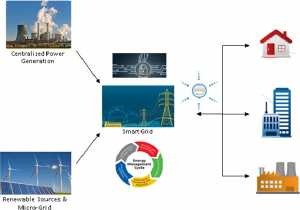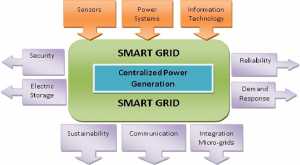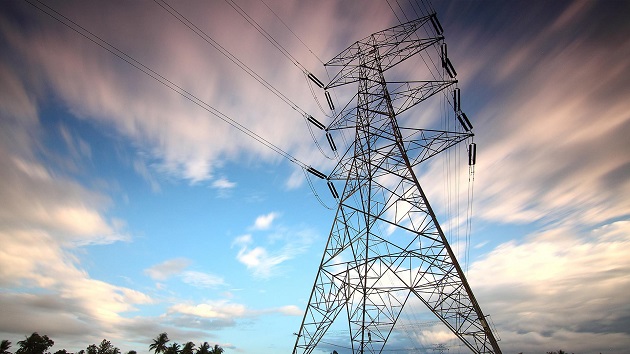Introduction
Urbanization, living standards and advancement in technology has increase the demand of energy requirement. This made electricity consumption rises to levels that may no longer be manageable if left unattended. This is an alarming situation not only for providing sustainable energy but also preservation of environment worldwide. Almost 75–80% of total energy consumption is consumed in cities which is responsible for 80% greenhouse gas emission. Traditional and centrally-controlled system for the distribution of electrical energy is being used for a long day. This is commonly name as power grid. Since the use of electricity, globally electric grids have similar structure, dynamics and principles even with the advancement of technology.
These traditional power grids are focused on only some of the basic functions like generation, distribution and control of electricity. The electricity grid in present form is unreliable, has high transmission losses, poor power quality, prone to brownouts and blackouts, supplying inadequate electricity, discouraging to integration of distributed energy sources. There is a lack of monitoring and real time control in the traditional non-smart systems, which creates a challenging opportunity for smart grids to act as a real-time solution. Countering these issues requires a complete overhauling of power delivery structure.
Smart Grid technology has a way for a solution for better generation of electric power and an efficient way for transmission and distribution of this power. Due to its versatility it can be more easily installed and required less space as compared to traditional grids. Concept of Smart Grid design is aimed for grid observability, create controllability of assets, enhance performance and security of power system and specially the economic aspects of operations, maintenance and planning. That’s why it is also consider that smart grid technology can be used to micro-grid level which eventually connect to all other micro-grids to form a large network of Smart Grid.
This article discusses an overview of the Smart Grid, its features and functions which includes reliability, security, energy management, self-healing. It will also discuss that how smart grid is changing the concept of grid technology and how much potential to revolutionized in modern electrical power grid.
Smart grid concept
There is no specific start of Smart Grid. This concept was start evolving with the start of distribution system of electrical networks. By the time different requirements were needed like control, monitor, prices and services of transmission and distribution of electrical power. Normally, Smart Grid implementation is associated with the installation of smart meter. The fundamental need which is under consideration with latest advancement is reliability and efficiency of energy transmission and distribution via electric power grid.
Definition
For the distribution of electrical power to consumer one need a network of electrical conductor which is known as grid. If this network is intelligent with automated control and monitor system than it might be known as Smart Grid. Technically, smart grid is a concept for the conventional grids with some latest and automated features which make them more reliable and sustainable. Conventional grids were use just to transmit and distribute the electric power but this modern concept of smart grid could communicate, store or even decide according to the situation.
A Smart Grid is an intelligent network of electricity that integrate the actions of all the stakeholders that are generators, consumers and one who does both in order to supply electricity with efficiency, sustainability, economically and securely. So Smart Grid is not a single technology that is to be implemented. Its vastness and dependency increases by its stakeholders as shown in Fig. 1.

It provides its stakeholder an opportunity to maximize the efficiency, reliability, economic performance and security of their electrical network. An overview of its architecture is shown in Fig. 2.

Design
To understand the design and concept of smart grid one has to understand its difference with the traditional power grid. This comparison is shown in Table 1.
Characteristics of smart grid
Features and functionalities of Smart Grid have a promise to full fill these requirements set by EISA.
Characteristics of smart grid
Features and functionalities of Smart Grid have a promise to full fill these requirements set by EISA.
Reliability
Success of the grid system depends upon the customer need which is measured as reliability. This mean as flaw less and error less system with continuous supply of electric power. Smart Grid has a potential to detect any fault and allow the self-healing of the system. Conventional grids have issues regarding interaction of renewable resources, micro grid and demand response. With increase the size and complexity of these grids with demand it makes more difficult to analyze its reliability. But these issues are very well addressed by Smart Grids. For this, Smart Grids have capability to monitor and store all the data and estimate its service reliability. It may also possible to monitor remotely for hybrid generation and management of the grid which enhance its reliability. Technologies like Dynamic Stochastic Optimal Power Flow (DSOPF) helps in estimating and optimizing the flow of power in Smart Grid. Therefore, Smart Grids can have better reliability with the advancement in communication system.
Security
Security is one of the challenging issues for the Smart Grid evolution. With the increase of automation, remote monitoring and controlling of the grid make the grid more vulnerable by cyber assault. According to Electric Power Research Institute, cyber security of the system is one of the biggest issue of the Smart Grid. Suleiman et al propose a way to identify the weaknesses of the smart grids that usually attackers exploit by using Smart Grid Systems Treats Analysis and by integration of Systems Security Threat Model. Similarly in 2014, Ashok et al proposed an approach to address cyber-physical security issue of Wide-Area Monitoring and protection and control from a coordinated cyber-attack perspective which will eventually enhance the security. Some of the promising ongoing research in different domains of security for smart grids include: Privacy-preserving smart metering with multiple data consumers, Ortho code privacy mechanism in Smart Grid using ring communication architecture and Security Threat Model. As security is to be consider one of the biggest barrier for implementation of Smart Grid technology, so ongoing these researches have promise to resolve this barrier.
Demand side management system
Smart grid provides the demand side or user to interact with the grid by using two ways communication ability. It provides a chance for the consumer to use the electric power in an economical way. It will not only help for increasing efficiency at demand side but also at distribution end. It helps grid to reduce demand and stress during peak period by reducing or shifting power requirement to alternatives. Currently, a lot of investment is being made in this sector of the smart grids including demand side resources, load management systems and energy efficiency initiatives in order to address economical, reliability and economic perspectives. Mostly demand side management systems focus only the communication between utility company and consumer. A new consumption scheduling technique is on the way to address the future grids in which each consumer can schedule their own consumption requirements.
With the evolution of Smart Grid, this definition has also started revolution in the appliances and utilities to be “Smart” known as smart devices. These have ability to communicate with the grid which make house more autonomous and facilitate the user to use the electric power effectively and efficiently. These appliances shift demand of household electricity. Different networking protocols like ‘ZigBee’ provides a solution to have a wireless control of household appliances. These protocols have ability to communicate and coordinate with all the stakeholders involved in home energy management system hence providing the best optimal solution to the user. Therefore, smart grid is changing the trends of conventional household appliances to ‘smart’.
Metering
Automation in distribution system is associated with the smart automatic meter. Metering provides a channel to enable two-way communication in Smart Grid concept between consumer and distributer. They not only help distributor for more accurate billing system but also help consumer to control their use of electrical energy. These meters are equipped with sensors for automation, power quality monitoring and power outage notifications. There are different drivers like price increase after electricity market deregulation, consumer dissatisfaction and monthly metering directives which encourages smart meters.
Advanced Metering Infrastructure (AMI) provides a real time solution that collects consumer data and provides a communication networks from grid to utility end. AMI provides opportunity to step forward for the modernization of the huge grids by combining consumer with the distribution system. It provides an opportunity for outage management, integration of electrical vehicles and smart devices, transformer and feeder monitoring and fault isolation. Researchers have design a new system for the automation of distribution of power through a Substation Automation System (SAS). This system has ability to solve congestion through locally control actions with a minimum limitation of renewable energy resources.
Micro-grids and integration of renewable resources
Power generation from renewable resources likes, solar, wind, battery storage devices are bean of high consideration to full fill the increasing demand of electricity and reducing the greenhouse gasses. They even help to reduce the power stresses from grid during peak hours. Normally sites for these resources are far or in remote areas. Even sometimes it is not possible to have a complete functional grid to transmit or distribute electric power. Here micro-grids are used, which gather to form a big distribution network. So with this large number of micro-grids and sources will result in large amount of data to be handle. So researches have a solution for this problem by using an architecture that uses an intelligent system all over the grid to distribute the power effectively. This system will not be used as centralized but will handle individually by mean of individual intelligent nodes.
Self-Healing
For a robust Smart Grid, it should not limited diagnose the fault occur in the grid but could also be able to remove it for a constant supply of electricity. For a grid with a self-healing ability it uses real-time communication and digital components that are installed throughout the grid to monitor electrical characteristics of the grid. With this ability, grid is smart enough and capable to figure out the potential problem that may be caused naturally or by some human error. These intelligent systems react instantly to any such abnormalities and isolate the problem system before they snowball into a big problem and cause major blackout and automatically reroute the transmission of power for continuous services unless the error is removed. There are three main benefits of a smart grid with self-healing capability: real-time monitoring and reaction, anticipation of problem, rapid isolation.
New technologies and research
A number of on-going research activities are being made for the advancement of the smart grid to make it more reliable and sustainable for the modern needs. These researches are focused on different technologies. It is difficult to cover all of these researches and advancement but this section includes some of the prominent and latest technologies and research activities associated with smart grid.
Energy management system
For a reliable grid, it’s essential that all the components involve must be work together from generation to consumption. There are a lot of complex components involved in the grid. These components communicate and work together by mean of some computer software. So, planning and its implementation on grid are done by mean of interoperability. NIST initiated smart grid interoperability (SGIP) which was responsible to develop and maintain the standards for smart grids and all the components involve must communicate and operate efficiently. It was also liable to provide a platform for all the stakeholders of power grid including customer, markets, service provider, power system, generation, transmission and distribution network to work together to form a modern, reliable and efficient grid system. For the understanding and implementation of energy management, both grids and consumer end must play their role. Technologies like advance metering infrastructure (AMI), communication network for grid and cyber security enables self-decision capabilities in grid which make energy management system more realistic for smart grid.
Internet of things (IoT)
Internets of things (IoT) take the internet to next step of evolution. It makes life easier, automate and handy by squeezing the whole world into one hand by computation and communication capabilities. With the advancement of smart grid and its components, a technology was needed to interact these components in an efficient, reliable and in more smart way. IoT has a promise to full fill all these characteristics taking smart grid into new era. But with this new technology, some serious security concern emerged which include impersonation, data tampering, overdoing, authorization, privacy issue and cyber-attack. IoT base smart grid must have services like authentication, confidentiality, user’s privacy and data integrity to avoid any security risk. Connectivity that IoT provides to customer, enhance their experience and efficiency. It allows customer a flexible and easy interaction with the grid in order to reduce cost by diagnostics and neighborhood-wide meter reading capability. In short, it makes smart grid smarter.
Big data
Smart grid is full depended upon the data it receives. It is not just eyes of the grid but work as back bone for it. For a reliable and efficient working of a smart grid, a huge amount of data is collected from power generation, transmission, transformation and power utilization. All the decision made by the grid is depended upon it. It also plays a key role in the autonomous capabilities of the smart grid. There are numerous challenges for big data in smart grid technologies which include from storage to its visualization and security. Researchers have also focused on how to combine data into information and beneficial application.
A large amount of data gathered from different sensors, wireless transmission and communications is accumulated. All the data gather from generation to utilization is used by different algorithms to forecast and will also help full in recognizing the pattern of power utilization. This will ultimately useful for achieving a smart energy management system. Energy big data does not only include the data gather from meters but it has also a huge amount of data related to weather and environment. Characteristics of this data are incomplete without ‘4Vs’ (volume, velocity, variety and value) and ‘3Es’ (energy, exchange and empathy). Different algorithms and models were develop for the analysis of the big data but still there are some major issues related to big data like: IT infrastructure, Data Collection and governance, data processing and analysis, data integration and sharing and most importantly security and privacy which are to be address and are centrally focused by researchers.
Future research in smart grid
A lot of research is undergoing for the development of smart grids. Still a lot of potential is available for future research for different aspects in different areas of smart grid. This include in area of forecasting, power flow optimization, communication, micro-grid integration, demand and energy management system, conformance of standards for interoperability, scalability, economical factors, data encryption and most importantly automation of generation, transmission and distribution.
Conclusion
Advancement of the technologies and devices can change the utilization of energy in an economical and environmental friendly way. Evolution of Smart Grid concept has potential to meet all the future needs of utilization of energy in best possible manner by reducing carbon emission and integrate with more renewable energy mix. It can bring a considerable change in the conventional grid and consumer behavior towards utilization of energy by improving reliability, efficiency and quality of power delivery. Governmental policies are needed to facilitate smart grid implementation. Still there is a lot of potential available for improving and implementation of this concept as it is just the start of the new era of modern grid. It is still difficult to predict that how far the research in smart grid is required to fully implement this concept but recent researches like smart meters, demand side management systems, self-healing and big data are source of encouragement in Smart grid technology.
Recent trends
Research and advancement on the smart grids have been seen tremendously increased in last decade. This is why smart grid technology has been shifted from virtual reality and concept to implementation phase. There was tremendous increase in the research in last five years in smart grid and soon this will be game changer in electrical power distribution with more flexibility and in efficient ways.








